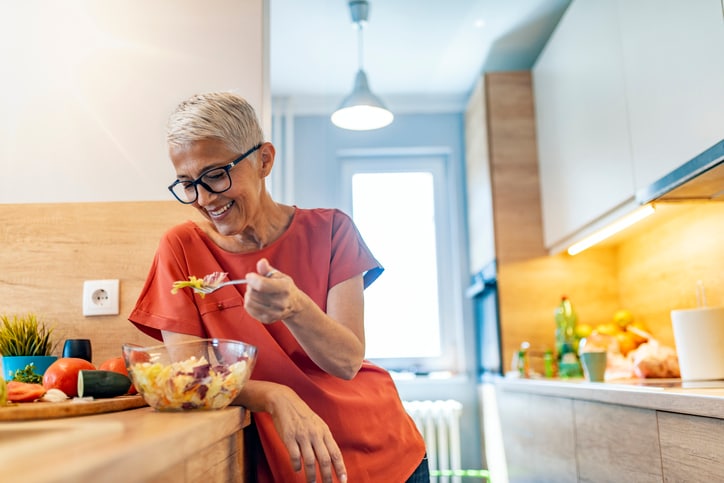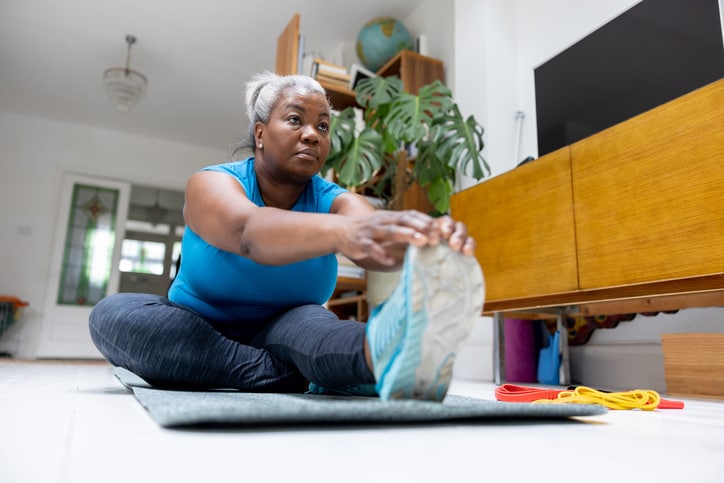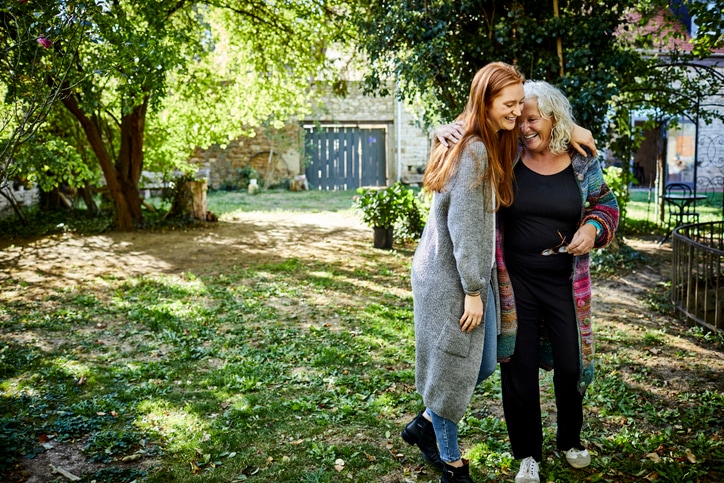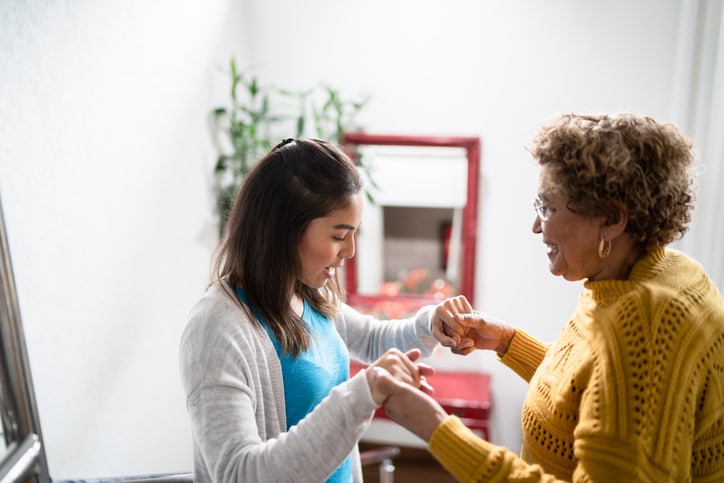If you’re caring for a senior, you are likely looking for effective ways to keep your loved one’s blood pressure in check. Sadly, the majority of seniors live with high blood pressure. An estimated 60% of people aged 60 and over have high blood pressure, and the risk of developing elevated blood pressure increases with age.
“The good news is that lowering your blood pressure can be done through changes in diet,” says Michelle Saari, a registered dietitian with the EHealth project. Dietary modifications can go a long way in helping to decrease blood pressure, and also contribute to overall positive cardiovascular health. Not only that, but it’s one of the areas you have some control over as a caregiver. After all, you may be doing the cooking, grocery shopping or meal planning for the senior in your care.
Here, we’ll take a look at foods that lower blood pressure, foods to stay away from and what experts say you can do to help your loved one keep their blood pressure in a healthy range.
What causes high blood pressure?
Seniors are more prone to developing high blood pressure for several reasons, says Christine Kingsley, an advanced practice registered nurse and the health and wellness director of the Lung Institute. “It could be related to existing conditions, specific kinds of medication, lifestyle habits such as smoking and/or alcoholism or a genetic predisposition for the disease,” she explains.
“Blood vessels become stiffer as we get older and cause more resistance in blood flow. This increased resistance is what we read as blood pressure.”
— Christine Kingsley, advanced practice registered nurse
But the most common reasons blood pressure risk increases as we age is because our blood vessels can lose elasticity, according to Kingsley. “Blood vessels become stiffer as we get older and cause more resistance in blood flow,” she says. “This increased resistance is what we read as blood pressure.”
What is an ideal blood pressure for seniors?
Ideal blood pressure ranges used to be different for seniors than for younger adults. These days, blood pressure guidelines don’t differentiate by age or even by sex. “Blood pressure goals have been recently revised for senior citizens,” says Dr. Majid Basit, a cardiologist at Memorial Hermann. “Clinical research indicates that achieving a blood pressure of 120/80 or less will help to prevent cardiovascular events.”
The Centers for Disease Control and Prevention (CDC) notes that high blood pressure diagnoses might vary from one healthcare provider to another, depending on which of the following guidelines they use:
- According to 2003 guidance from the Joint National Committee on Prevention, Detection, Evaluation and Treatment of High Blood Pressure, high blood pressure is a reading of 140/90 or above on a consistent basis.
- According to 2017 guidance from The American College of Cardiology and The American Heart Association, high blood pressure is a consistent reading of 130/80 or higher.
Both thresholds are accepted by major health organizations, but it’s important to talk with your provider if you have questions about their diagnosis or treatment plans. Additionally, it’s always OK to seek a second opinion.
Is it possible to lower blood pressure with diet?
“Yes, you can lower blood pressure with dietary changes,” Kingsley assures. The most effective and evidence-based way to do this is by adopting a DASH diet. DASH stands for: Dietary Approaches to Stop Hypertension.
“The DASH diet is part of the non-pharmacological therapy for patients, and it emphasizes the importance of a diet that is rich in fruits, vegetables and low-fat dairy products and reduced in fat and cholesterol,” Kingsley explains.
Best foods to lower blood pressure
There are many delicious foods seniors can eat on a low blood pressure diet. Bailey Franklyn, a registered dietitian with over seven years’ long-term care experience, says her go-to foods to help lower blood pressure include fruits and veggies, seeds, unsalted nuts, whole grains, fish and low-fat dairy products. Here are some foods she and other experts recommend:
Potassium-rich fruits and vegetables
“Potassium helps to reduce the amount of sodium that the body holds onto and get rid of it in urine,” Saari explains. “This can help to reduce blood pressure.” Some foods with high potassium content include:
- Spinach.
- Bananas.
- Sweet potatoes.
- Leafy greens.
- Cooked broccoli.
- Grapefruit.
- Cantaloupe and honeydew melon.
- Apricots.
Whipping up a healthy salad with a spinach base, or a smoothie with bananas and spinach, are excellent choices. Bananas in particular are fabulous options for seniors, Saari says. “Bananas are a rich source of potassium, with about 350 mg in one medium banana,” she explains. “They’re also a very soft, inexpensive and easy to eat fruit.”
Berries
Bananas aren’t the only fruit to increase in your loved one’s diet. Any type of berry — blueberries, strawberries, raspberries, etc. — can help lower blood pressure. Berries pack a punch in terms of fiber, Saari says. They’re also high in something called flavonoids. “Flavonoids, or specifically anthocyanins, help to produce nitrous oxide, which translates to relaxing blood vessels, which helps to lower blood pressure naturally,” she explains.
Nuts and seeds
As Kingsley notes, nuts are excellent foods to add to your blood pressure-lowering meal plan. “These work primarily because they are rich in the minerals potassium and magnesium, which both have vascular benefits for the body,” she explains. Nuts and seeds are also fantastic sources of fiber, zinc and heart-healthy fats.
When considering nuts, it’s best to go for unsalted ones, as salt can increase blood pressure. Some different types of nuts and seeds to try include:
- Almonds.
- Cashews.
- Hazelnuts.
- Macadamias.
- Pecans.
- Pistachios.
- Walnuts.
- Pine nuts.
- Peanuts.
- Chia seeds.
- Pumpkin seeds.
- Flax seeds.
- Sunflower seeds.
Whole grains
Foods that are high in fiber have vasodilatory effects, says Kingsley, meaning that these foods improve blood flow in our blood vessels, which decreases blood pressure. Oats are a great way to add whole grains to your diet, Kingsley recommends, so making a morning bowl of oatmeal part of your routine is a wonderful idea. Other beneficial whole grains include:
- Barley.
- Millet.
- Quinoa.
- Popcorn.
- Wild rice.
- Whole grain breads, cereals and crackers.
Low-fat dairy products
Researchers have found links between the consumption of low-fat dairy products and lower blood pressure. This may be because calcium, like potassium and magnesium, has blood-pressure lowering effects.
Still, experts say it’s important to eat low-fat or fat-free dairy products. Full-fat dairy is a source of saturated fat, which can have negative impacts on blood pressure and cardiovascular health. Try adding foods like low-fat or fat-free milk, yogurt or cottage cheese to your daily diet.
Fish and lean meats
Fish and lean meats are good sources of low-fat protein that are recommended as part of any DASH diet, though they shouldn’t play as prominent a role as fruits, veggies and whole grains. The DASH diet recommendations suggest aiming for about six ounces of protein a day. Recommended meats include chicken, turkey and fish.
Additionally, remove fat and skin from any meat or fish you cook. It’s also best to bake, grill or roast the fish or meat, rather than frying it. Those hoping to lower blood pressure should also avoid red meat.
What does a blood pressure-friendly meal look like?
Franklyn recommends building healthy and yummy meals out of foods that are naturally low in sodium and high in potassium. Here are some simple meal ideas Franklyn suggests, based on these nutritional goals:
- Baked salmon with roasted sweet potatoes, broccoli and a side of wild rice.
- Canned tuna on a bed of mixed greens with a simple olive oil vinaigrette.
- Vegetarian chili with kidney beans, chickpeas, low-sodium canned tomatoes, carrots, celery, corn and garnished with avocado.
Additionally, instead of using salt to add flavor to foods, Franklyn recommends adding:
- Garlic.
- Lemon.
- Herbs.
- Spices.
Foods to avoid when trying to lower blood pressure
When it comes to diets for lowering blood pressure, it’s not just about what you eat, but what you don’t eat. If you are looking to lower blood pressure, experts say to avoid foods high in saturated fat, processed foods and sugary foods.
“Most restaurant food, fast food and pre-made meals are loaded with salt and fat, both of which are bad for people needing to lower their blood pressure.”
— Michelle Saari, registered dietitian
But, the most important ingredient to say away from? Salt. For example, a DASH diet limits salt intake to 2,300 milligrams a day. One easy way to stay within that range is to make more home cooked meals, Saari suggests.
“Most restaurant food, fast food and pre-made meals are loaded with salt and fat, both of which are bad for people needing to lower their blood pressure,” she explains “Start cooking at home and making the majority of your meals from scratch, and you should notice a difference relatively quickly.”
What else helps lower blood pressure?
Diet isn’t the only lifestyle modification that can help lower blood pressure. In addition to diet, exercise is one of the key elements in managing blood pressure naturally.
“Maintaining a healthy body weight and improving blood circulation through exercise has been shown to significantly boost the effects of diet modifications in managing hypertension,” Kingsley says. “We usually recommend seniors do at least 30 minutes of light to moderate exercise to achieve this.”
Other important elements of managing blood pressure include:
- Managing stress.
- Limiting alcohol.
- Staying at a healthy weight.
- Getting plenty of exercise.
- Monitoring blood pressure regularly, at home and at doctor visits.
- Taking prescription blood pressure medication when needed.
The bottom line
Lowering your blood pressure through dietary changes is possible, and caregivers play an important role in ensuring that seniors eat a diet rich in blood pressure friendly foods. Still, it’s important to keep your eye on the bigger picture when it comes to medical conditions like high blood pressure, and always stay in touch with your loved one’s healthcare providers.
“For some people, dietary changes alone may be enough to see improvements in their blood pressure, but others might require dietary changes along with medication,” Franklyn says. Either way, there are numerous ways to achieve lower blood pressure and maintain your health as you age.






